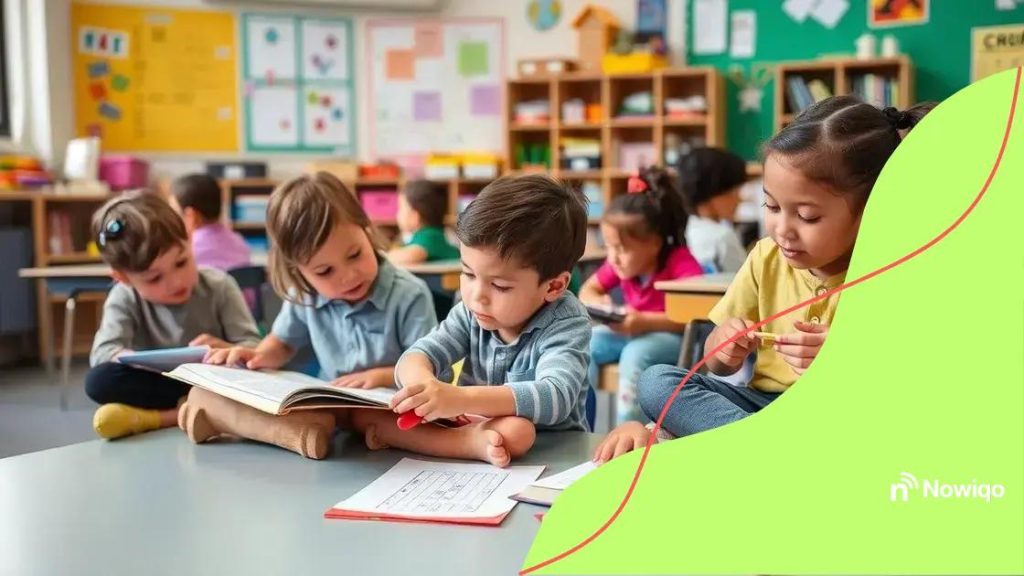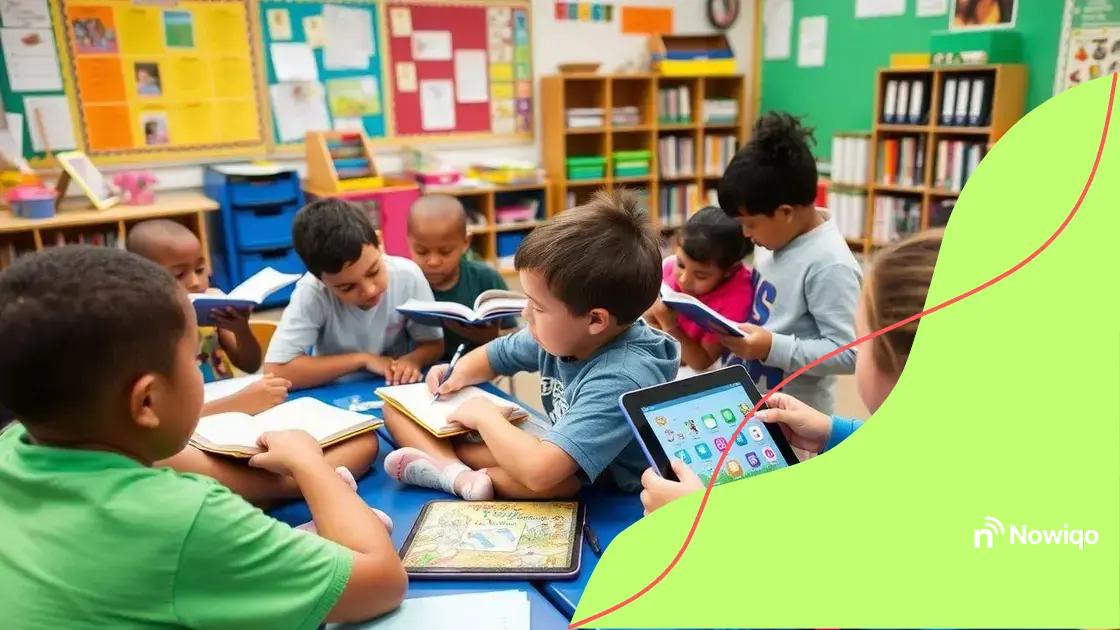Literacy and numeracy goals: how to achieve success

Anúncios
Setting clear literacy and numeracy goals is essential for effective learning, as it helps educators track student progress, enhances motivation, and connects academic skills to real-life applications.
Literacy and numeracy goals lay the foundation for effective education. Have you ever wondered how they can shape a child’s future? In this article, we delve into essential strategies that foster these skills.
Anúncios
Understanding literacy and numeracy goals
Understanding literacy and numeracy goals is vital for effective education. These goals guide schools and educators in enhancing students’ skills. They enable a structured approach to teaching, ensuring students achieve essential competencies.
What Are Literacy Goals?
Literacy goals focus on reading, writing, and communication skills. They aim to help students understand texts and express themselves clearly. This foundation is crucial for academic success and lifelong learning.
- Promote effective reading strategies.
- Encourage writing clarity and structure.
- Enhance vocabulary and comprehension.
What Are Numeracy Goals?
Numeracy goals concentrate on mathematical skills. These include basic arithmetic, problem-solving, and logical reasoning. A strong grasp of numeracy is essential for everyday activities and future studies.
Anúncios
- Strengthen basic number operations.
- Develop problem-solving abilities.
- Improve data interpretation skills.
When educators align their teaching methods with these goals, they create a cohesive learning experience. This allows students to progress at their own pace while achieving essential benchmarks. Adopting a structured framework facilitates successful learning outcomes and fosters confidence in both literacy and numeracy. Journeys toward mastery in these areas can be engaging and inspiring when approached with creativity and enthusiasm. In classrooms, teachers can use various resources, including technology, to enhance these skills. By incorporating activities that promote collaboration and interaction, students can better understand complex concepts and retain information more effectively.
Importance of setting clear goals
The importance of setting clear goals cannot be overstated in education. Clear goals guide both teachers and students in the learning process. They provide direction, foster motivation, and create a sense of purpose.
Why Clear Goals Matter
When goals are specific and measurable, students can track their progress. This not only builds confidence but also helps identify areas where improvement is needed. Furthermore, clear goals encourage accountability among students, instilling a sense of responsibility toward their learning.
- Promotes focused learning experiences.
- Encourages self-reflection and adjustment.
- Enhances motivation and engagement.
How to Set Effective Goals
Effective goal-setting involves specific, measurable, achievable, relevant, and time-bound (SMART) criteria. Following these guidelines can lead to success in both literacy and numeracy. For example, instead of saying, “I want to improve my math skills,” a SMART goal would be, “I want to increase my math test score by 10% by the end of the semester.” This approach provides clarity and motivates students to work harder.
Additionally, teachers can help students set these goals during classes. By involving students in the goal-setting process, it fosters ownership of their learning journey. They feel empowered and more likely to stay committed to achieving their objectives. When classroom environments prioritize clear goal-setting, both teachers and students thrive.
Strategies for improving literacy skills

Improving literacy skills is essential for students in any learning environment. Various strategies can help enhance reading, writing, and comprehension abilities. Each approach should be tailored to meet the needs of individual learners, allowing them to thrive.
Engaging Reading Activities
One effective strategy is incorporating engaging reading activities. When students read materials that interest them, they become more motivated. Teachers can introduce book clubs or reading challenges to foster a love for reading.
- Use themed reading weeks.
- Incorporate multimedia resources.
- Encourage discussions around books.
Writing Exercises
Writing exercises also play a crucial role in developing literacy. Encouraging students to write about topics they are passionate about can lead to better engagement. Journal writing allows for creativity while boosting writing skills.
Additionally, peer reviews can enhance their ability to critique and improve their work. Regular practice with different types of writing—such as essays, stories, and persuasive pieces—helps solidify their skills. Ensuring feedback is constructive and specific enables students to understand their strengths and areas for improvement.
Utilizing Technology
Technology can be a powerful ally in improving literacy. There are numerous apps and online platforms designed to enhance reading and writing skills. Tools that provide interactive learning experiences can make literacy practice enjoyable and effective.
By integrating technology into the classroom, educators can offer dynamic lessons that engage students. Using games, quizzes, and interactive reading platforms makes the learning process more appealing, especially for younger learners.
Strategies for enhancing numeracy skills
Enhancing numeracy skills is crucial for students as it lays the groundwork for their mathematical understanding. Developing strong numeracy skills provides students with the confidence to tackle mathematical problems in their everyday lives and future studies.
Interactive Learning Techniques
One strategy to enhance numeracy is through interactive learning techniques. Games and hands-on activities can make math concepts fun and engaging. For example, using board games that involve counting or strategy allows students to practice their skills in a relaxed environment.
- Incorporate math puzzles and riddles.
- Use physical objects to teach counting and operations.
- Engage students with math-based online games.
Real-Life Applications
Connecting math to real-life situations also helps students understand its relevance. Showing how numeracy skills apply to everyday tasks fosters interest and motivation. For example, cooking requires measuring ingredients, which provides a practical application for fractions and addition.
Another effective tactic is to encourage students to manage a budget for a pretend shopping experience. This activity teaches them to use addition, subtraction, and estimation in a meaningful way. By relating math to real-life experiences, students can appreciate its importance.
Collaborative Problem Solving
Additionally, collaborative problem-solving activities can be beneficial. Group work encourages students to discuss their thought processes and learn from one another. When students share strategies and approaches, they can develop a deeper understanding of numeracy concepts.
Teachers should create an environment where students feel safe to articulate their thoughts. This not only builds their confidence but also enhances their problem-solving abilities. Working together can foster a sense of teamwork and help students see how diverse perspectives can lead to effective solutions.
Measuring success in literacy and numeracy
Measuring success in literacy and numeracy is vital to understanding a student’s progress. Knowing how to assess these skills helps educators tailor their instruction to meet the needs of each learner. Effective assessment strategies provide insights into areas where students excel and where they may need additional support.
Assessment Tools
Various assessment tools can be used to measure literacy and numeracy skills. Standardized tests offer a benchmark for evaluating student performance against national or state standards. However, incorporating formative assessments, such as quizzes and class activities, helps to track progress continuously and provides immediate feedback.
- Use reading comprehension tests to evaluate literacy.
- Incorporate math tests to assess numeracy skills.
- Implement observational assessments during classroom activities.
Setting Benchmarks
Setting clear benchmarks is crucial for measuring progress in literacy and numeracy. Educators should establish goals that are challenging yet achievable. For instance, a benchmark could involve increasing reading levels by a specific grade each year. This approach gives students clear objectives to work towards, motivating them to improve.
Regularly reviewing these benchmarks ensures that students remain on track. When educators and students revisit these goals, it allows for adjustments based on individual progress. This practice encourages a collaborative approach to learning where students feel actively involved in their educational journey.
Involving Families
Involving families in the assessment process strengthens the connection between home and school. Parents can play a crucial role in supporting literacy and numeracy development. Informing families about assessment results fosters communication and partnerships in their child’s education.
Schools can organize workshops or provide resources to help families understand how to support learning at home. When families are engaged, students tend to perform better, knowing they have support both in school and at home.
In conclusion, understanding literacy and numeracy goals is essential for developing effective learning strategies. By setting clear objectives, using diverse assessment methods, and involving families, educators can create a supportive environment that promotes student success. Engaging activities that cater to different learning styles are key to maintaining student interest and motivation. Through continuous evaluation and adaptation of teaching methods, we can ensure that all students have the opportunity to thrive in their literacy and numeracy skills.
\n\n
\n
FAQ – Frequently Asked Questions about Literacy and Numeracy Goals
Why are literacy and numeracy goals important?
These goals are essential because they provide structure and direction for student learning, helping educators track progress and ensure skills are developed.
How can I measure my child’s literacy and numeracy skills?
You can measure skills through standardized tests, observation, and regular assessments that provide insight into your child’s understanding and abilities.
What strategies can help improve literacy skills?
Engaging reading activities, writing exercises, and using technology are effective strategies to enhance literacy skills in students.
How can I support my child’s learning at home?
Encouraging reading at home, practicing math through everyday activities, and maintaining open communication with teachers can significantly support your child’s learning.